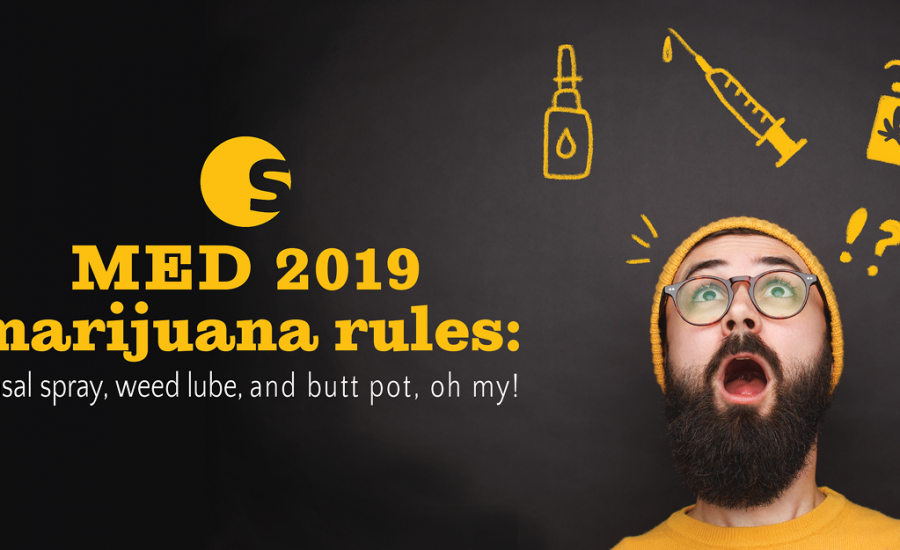On November 9, Colorado’s Marijuana Enforcement Division (MED) announced that the 2019 marijuana rules have been adopted. For a Regulatory Analyst at Simplifya, that kind of news means it’s time to hunker down with 500 pages of redlined rules and figure out what our clients will have to change on January 1. FUN!
More than meets the eye
The MED has a nice overview of the new changes. Growers are now allowed to give their leftover plant parts to producers of hemp-type products; “kief” gets a new legal definition (in case you hadn’t learned about it through personal experience); labs are required to test for heavy metals; and certain managers are allowed to sample their own products. Each of these developments is pretty cool, but the big change that piqued my interest? Audited and Alternative Use Products.

Wow, that sounds pretty dry, doesn’t it? It sure does! Until you take a look at the 2019 marijuana rules for these things. “Vaginal… or rectal administration”? “[U]se of a syringe for any type of injection”? Yikes! What are we dealing with here? Are these rules in response to widespread use of injectables and suppositories? Are there really a bunch of people out there boofing (not the way you mean it, Kavanaugh) and actually injecting marijuanas? Well… sort of, but not really.
The nitty-gritty of the new 2019 marijuana rules
Most non-emergency regulations these days are written as a precautionary measure with the intent of squashing a problem before it is actually a problem. When it comes to audited products, this is definitely the case. At Simplifya, our analysts try to go above and beyond when it comes to keeping on top of regulations. This includes attending rulemaking meetings when we can. It just so happens that we were there to witness the discussions that led to these new products rules.

The rules were originally intended to make sure that special medical products (like THC/CBD inhalers and nasal sprays) were delivering reliable doses for patients. But at this meeting, certain concerned citizens steered the discussion toward THC suppositories. They believed that impressionable youth were using the products as a means to get a faster, stronger high. The meeting also featured a blunt-tip syringe with marijuana-concentrate being confused for a hypodermic syringe (think turkey baster vs. needle drugs).
As far as we can tell, these discussions were the motivation for the new audited product rules, because we had analysts at every other MED meeting and those products were not discussed. The MED ultimately decided to apply the inhaler and nasal spray rules to suppositories as well, requiring the products to undergo extra rounds of testing on top of the tests required for regular marijuana products. It also decided to clarify that there is no way injectable marijuana will be allowed as a commercial product.
So are these forms the newest way to get stoned?
As it happens, marijuana suppositories are not the new hot way to get high. Suppositories actually gained popularity in the medical community, because unlike alcohol, when you put marijuana “up there,” the psychoactive chemical does not get to your brain faster or in larger doses.

Medical marijuana users found that suppositories made it easier to get the medicinal effects of large doses without getting the kind of “head high” they would if they had smoked, vaped, or eaten the same amount. Concerned citizens have pointed to companies that sell marijuana lube as evidence that the products are being used recreationally, but again, these products are worse for getting high than edibles, and all the testimonials and advertising make it clear that these products are intended for sexual health uses—not sexual enhancement. Suppositories are generally used to treat menstrual cramps, muscle spasms, tumors, and digestive issues.
And although it is possible to make a pure THC solution and inject it, it is very difficult to make such a solution—THC is a terpene, which makes it more of a syrupy consistency and really hard to inject. It also doesn’t look very pleasant; I can’t imagine anyone wanting to be that high. Although just to make sure, the MED added that injectable THC is banned in their newest regulations.
tl;dr: Don’t let the new 2019 marijuana rules scare you. No one is injecting marijuana or putting it in their no-no places to achieve new highs.
